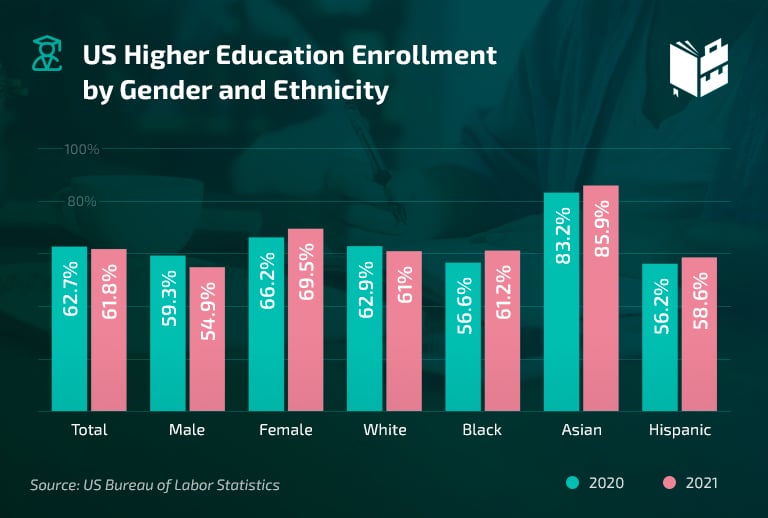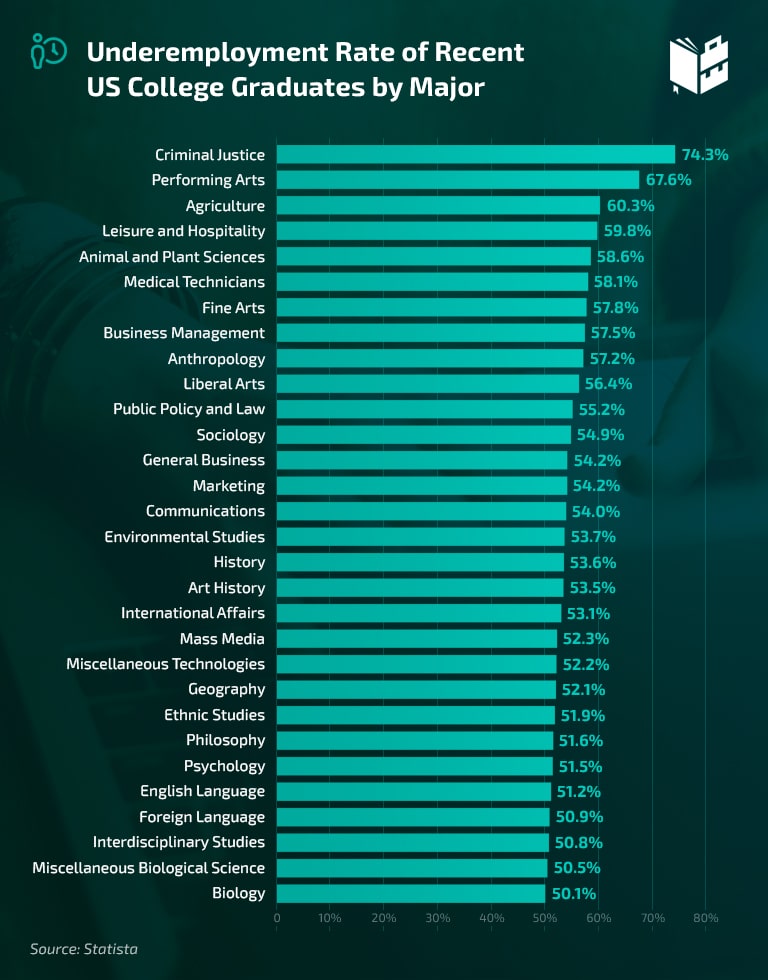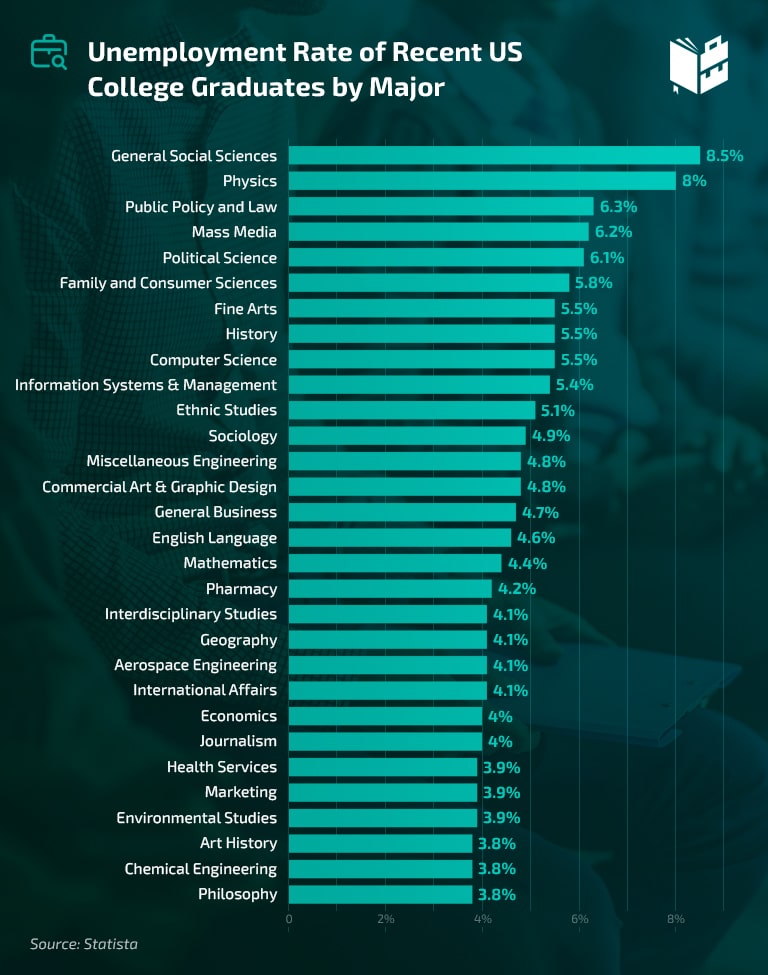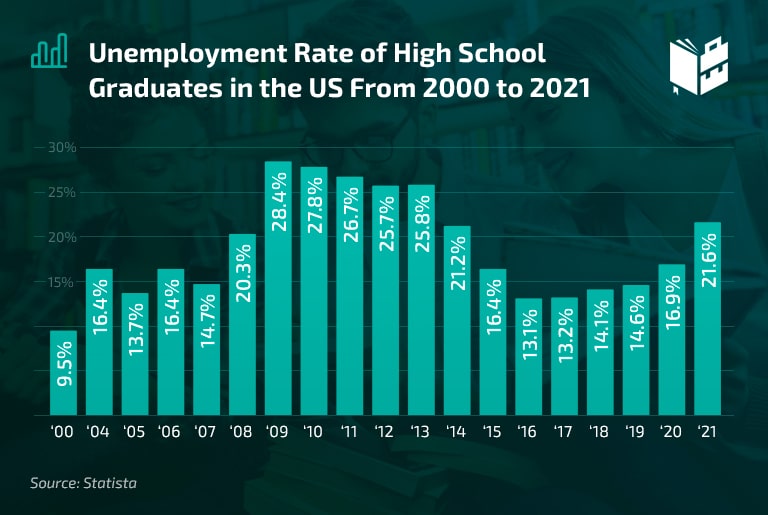College graduates’ unemployment rate is one of those topics that we shouldn’t avoid. Students across the US are willing to get into tremendous debt to obtain a degree, only to face no job opportunities once they’ve graduated.
Therefore, readers should pay attention to the statistics listed below. They explain how saturated some professions are, which majors would potentially be a waste of time and money, and which ones offer a straightforward pathway to a job.
Key College Graduates Unemployment Rate Facts and Statistics
- Approximately 61.8% of high school graduates enrolled in college last year.
- Around 53% of recent college graduates are unemployed or underemployed.
- The unemployment rate for those with a bachelor’s degree or higher is 4%.
- Mass media majors have an unemployment rate of 6.2%.
- General education majors have an unemployment rate of just 1.7%.
- 41.4% of college graduates are underemployed in their first job.
- In total, 33.8% of college graduates are underemployed.
- 74.3% of criminal justice majors are underemployed.
General College Grad Statistics
1. The percentage of people who are 25 or older with a bachelor’s or higher degree increased to 37.9%.
(Census)
There are currently 52.8 million people aged 25 or more who are holders of a bachelor’s degree, translating to almost 38% US citizens in this age group. Moreover, according to college graduates employment statistics, there are approximately 32.2 million individuals who have attained a master’s degree or higher.
2. 61.8% of high school graduates enrolled in college in 2021.
(US Bureau of Labor Statistics)
In 2021, fewer high school graduates enrolled in college, as 62.7% enrolled the year before. While 69.5% of female graduates enrolled in college, 54.9% of male graduates did. Also, 85.9% Asian people enrolled, while the rates for Black, White, and Hispanic peoples were 61.2%, 61%, and 58.6%, respectively.

3. Bachelor’s degree holders see ROI only after 15 years of working full-time.
(Education Data)
College graduates job statistics show that the return on investment in a bachelor’s degree in the first 10 years after graduation is -41.1%. On the other hand, graduates with a bachelor’s degree see an ROI of 38.8% after 20 years of full-time employment, while their lifetime ROI stands at 287.7%. However, when we compare it to other investments, like bonds (3%) and stocks (7%), it’s worth it for most people.
4. There are more than 60 million bachelor’s degree holders in the civilian labor force.
(US Bureau of Labor Statistics)
The most significant part of the US civilian labor force has at least a bachelor’s degree. On the other hand, the number of people with an associate’s degree or some college that are in the civilian labor force stands at 35,757.
5. Roughly 53% of recent graduates are unemployed or underemployed.
(University of Washington)
The average college graduate needs up to half a year to find their first employment. Even with a perfect resume, references, and an established job-seeking strategy, they are unlikely to find work in their field or even one that requires a college degree.
Statistics on College Graduates Getting Jobs
6. The unemployment rate for those with a bachelor’s degree or higher is 4%.
(Statista)
The unemployment rate for those with a bachelor’s degree or higher stays relatively low if we consider the fact that the unemployment rate has increased drastically because of the coronavirus pandemic. The record high was observed in June 2020, when the rate stood at 13.3%.
7. The unemployment rate for associate degree holders in the US is 7.1%.
(Statista)
The unemployment rate for college graduates data offers some good news: young people shouldn’t question their decision to attend college, as those who only have a high school diploma have an even harder time finding work.
8. Median earnings for recent graduates are higher today than they were in 1990.
(Federal Reserve Bank of New York)
Recent college graduates earn more than their predecessors did in 1990 or 2000. In 1990, the median pay for recent graduates was $48,481, slightly dropping to $47,211 in 2000.
College graduate employment rate data implies that the median yearly income for those aged 22 to 27 with a bachelor’s degree today is $52,000.
9. Recent college graduates are 5.7 times more likely than workers overall to be advertising and promotion managers.
(Harvard Business Review)
Taking the share of recent graduates with a bachelor’s degree aged 22 to 27 who work in the position and dividing the figure by the overall number of workers in it, we can determine that recent grads are 5.7 times more likely to be advertising and promotion managers.
10. Interest in arts and entertainment is increasing, and the interest in graphic design is the highest.
(Indeed)
There’s no issue with the college graduates unemployment rate in some professions:
Interest in arts and entertainment-related jobs among recent graduates spiked. For this population, the list of top 10 occupations by interest now looks like this:
- Graphic designer
- Industrial engineer
- Film and video editor
- Psychiatric technician
- Marriage and family therapist
- Art, drama, and music teacher
- Writer
- Counselor for substance abuse and behavioral disorders
- Photographer
- Social worker
11. Interest in occupations related to business and finance drops the most.
(Indeed)
The college graduates unemployment rate has increased in some professions due to a loss of interest in others.
Even though they pay better, jobs related to business and finance are not making any top lists these days. What’s more, the interest in jobs that come with a high risk of injury is also dropping. Here is the list of the top 10 occupations that recent graduates are losing interest in:
- Radiation therapist
- Statistician
- Statistical assistant
- Speech therapist
- Economist
- Actuary
- Sales person
- Nutritionist and dietitian
- Forester
- Nuclear engineer
College Graduate Underemployment Rate
12. 41.4% of college graduates are underemployed in their first job.
(Statista)
Underemployment is the number that represents the percentage of graduates working in positions that do not require a college degree. If at least 50% of people in a certain occupation have a bachelor’s degree, that position is classified as a college job.
Two out of five people who graduate from college with a bachelor’s degree can expect their first job to not require any degree, according to college graduates job statistics.
13. 33.8% of all college graduates are underemployed.
(Inside Highered)
When talking about college graduates, everyone between the ages of 22 and 65 with a bachelor’s (or higher) degree is considered. Unfortunately, over a third of them are in positions they are overqualified for.
14. 74.3% of criminal justice majors are underemployed.
(Statista, Criminal Justice Degree Hub)
Some degrees face severe underemployment rates. Even though it’s not one of the majors with the highest unemployment rate, getting a bachelor’s in criminal justice will almost certainly lead to underemployment, as just over a quarter of those who graduate with this degree end up working in positions that require it.
15. 51.5% of psychology majors are underemployed.
(Statista, Psychology Today)
Even though most psychology majors dream about becoming counselors or therapists and positively impacting peoples’ lives, more than half of them don’t get that chance. According to the college graduate employment rate data, most of them are employed as HR representatives and psychiatric technicians.

16. 12.1% of nursing majors are underemployed.
(Statista)
For those who opted to go to nursing school, the situation is on the opposite end of the spectrum. A little over 12% of those with a degree in this field are underemployed, while 1.8% are unemployed.
In case you’re interested in unemployment rates for specific majors, you’ll find the following section particularly interesting.
Unemployment Rate by College Major
17. The unemployment rate for mass media majors is 6.2%.
(Statista, CareerExplorer)
The unemployment rate for those graduating in mass media is double that of the average. Those who find a job in this highly competitive field can expect their starting salary to be around $32,698, growing to an average of $48,633 after five years of experience.

18. The unemployment rate for anthropology majors is 3.5%.
(Statista, CareerExplorer)
Sorting the unemployment rate by degree, we can see that earning a BA or BS degree in anthropology also puts graduates in a difficult position when finding work.
However, their unemployment rate is slightly lower than the college graduate average. What’s more, the starting salaries in this field are estimated at $37,870.
19. Liberal arts majors’ unemployment rate is 3.2%.
(Statista, Zippia)
According to education statistics and college grad unemployment data, liberal arts majors have a 0.4% lower unemployment rate than the college graduate average. The national starting salary for recent liberal arts graduates can vary between $21,218 and $63,293, depending on the amount of previous experience.
20. The unemployment rate for economics majors is 4%.
(Statista, Zippia)
Economics used to be regarded as a field with a secure job line. However, the stats about the unemployment rate by college major indicate that college graduates face difficulties while searching for jobs in this field.
Those who find a job can expect to do well, though, as the median salary data shows some impressive figures — salaries for beginner economist positions to be $62,460.
21. The unemployment rate for health services majors is 3.9%.
(Statista, Zippia)
The unemployment rate for college graduates in health service is not much higher than the average, but it shouldn’t be neglected
Pursuing an education in general medical and health services doesn’t only represent an act of selflessness and desire to help. It’s also a smart move when it comes to future employment. Less than 4% of those with a bachelor’s in this field are unemployed.
The median pay for recent graduates is not too shabby either, sitting at $52,800, college graduate stats on salaries show.
22. General education majors’ unemployment rate is 1.7%.
(Statista, Zippia)
As elementary and high school teachers are always needed, this major’s unemployment rate will likely remain at 1.7% for the foreseeable future. Recent general education graduates can expect to earn about $44,800.
Unemployment Rate for College Graduates vs. High School Graduates
23. The proportion of the US population with at least a high school diploma is above 90%.
(Statista)
With the increase in education, the number of people with high school diplomas has dropped significantly. The rate of those who never graduated from high school has also gone down. Nowadays, around 91.6% of women and 90.6% of men own a high school diploma or a degree.
24. The unemployment rate for high school graduates in the US is 21.6%.
(Statista)
Considering the unemployment rate for college graduates data, high school graduates have considerably higher unemployment rates than college graduates. The situation has worsened due to the coronavirus pandemic.

25. The median pay for college graduates is around 61.4% higher than those with just a high school degree.
(NCES)
When all bachelor’s degree holders are taken into account, college graduates statistics show a median yearly salary of $59,600. For high school graduates, median pay sits at $36,600. That is another reason why students should carefully evaluate and explore colleges with the best job placement rates.
26. The US government invested $100 million in apprenticeships in 2020.
(Industry Week)
On-the-job training is one of the best ways to improve the job status of those without a college degree. More than $100 million was invested in high-tech apprenticeships. Improving their skillset is one of the only ways for high school graduates to reduce the pay gap between them and the college-educated workers.
College Graduates Unemployment Rate — Conclusion
Students and college graduates should know more about employment, as it can help them find a job. However, unemployment rates shouldn’t scare them. Instead, they should motivate them to give their best to find a suitable and well-paid job.
Choosing the field they are passionate about should be the number one priority for those selecting a college major. No matter which one they choose, those who are best in their fields shouldn’t worry about finding a job.